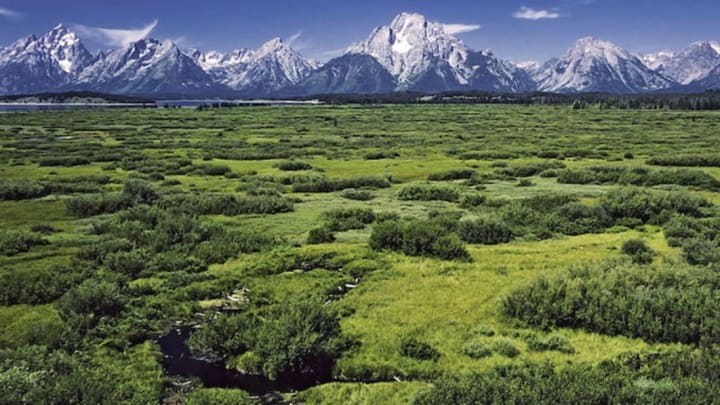Grand Teton earned its place as one of the 10 most-visited national parks in the country by welcoming over 2.5 million people to the alpine-esque wilderness of Wyoming each year. Located just 10 miles south of Yellowstone National Park, the popular destination has a history filled with as many highs and lows as the mountain range within its boundaries. Here are a few things you might not know about this 310,000-acre attraction.
1. THE TETON RANGE BOASTS BOTH AGE AND YOUTH.
The park’s iconic feature, the 40-mile-long Teton Range, is the youngest range in the Rocky Mountains. In fact, they are actually some of the youngest mountains in the world. Still, the rocks in the park are some of the oldest in North America.
2. THE PARK WAS ESTABLISHED FOR THE FIRST TIME IN 1929.
Despite extreme opposition, President Calvin Coolidge approved the original 96,000-acre park on February 26, 1929. This act protected the Teton Range and six glacial lakes but not nearby Jackson Hole.
3. PARK CONTROVERSY SPARKED A CATTLE-DRIVE PROTEST.
Although conservation of Jackson Hole was important, residents were opposed to expanding the national park into the valley. President Franklin Delano Roosevelt created the Jackson Hole National Monument by presidential proclamation in 1943, ignoring public disapproval. In response, infuriated ranchers led over 500 cattle across the designated land, led by movie star Wallace Beery.
4. THE PARK WAS ESTABLISHED—AGAIN—IN 1950.

m01229, Flickr // CC BY-NC-ND 2.0
Both during and after World War II, Wyoming and its senators kept fighting to undo the monument’s creation. But every time the senators or the state got close to repealing the designation, it would get vetoed. Eventually, both sides recognized that this fight was going nowhere and both sides agreed to the national monument being added to the original park and Grand Teton National Park was re-established. But in exchange, ranchers were allowed their existing grazing rights, the elk herd would be managed in part by the state which would allow supervised hunting, and Wyoming was exempted from the Antiquities Act that allowed the president to unilaterally designate National Monuments, meaning that any new National Monuments in the state had to be agreed upon by Congress.
5. JOHN D. ROCKEFELLER, JR. WAS PRO-PARK FROM HIS FIRST VISIT.
After John D. Rockefeller, Jr. visited northwest Wyoming in 1924 and 1926, he was convinced to purchase land in Jackson Hole that he would eventually donate to the federal government. Rockefeller created the Snake River Land Company to protect his identity (and keep the land prices reasonable) as he bought the property. He held onto the 35,000 acres for 15 years before threatening to sell it, which many believe prompted FDR to create Jackson Hole National Monument.
6. THE MYSTERY OF AMERICA’S FIRST MOUNTAIN MAN LIVES ON AT GRAND TETON.
John Colter, largely considered to be America’s first mountain man, explored the country’s wilderness after departing from the return trip of the Lewis and Clark expedition in 1806. While historians know where Colter’s journey began and ended, there are no truly accurate records regarding his whereabouts in between. However, a human-head-shaped stone found in Idaho in 1931 could provide some insight. The stone is engraved with “John Colter” and “1808.” The Colter Stone hasn’t been authenticated, but if it’s real, its original location could confirm Colter’s travels through the Teton Pass. The stone has been displayed in a museum at one of the park’s visitor centers.
7. THERE’S A COMMERCIAL AIRPORT ON PARK GROUNDS.

terkel110, Flickr // CC BY-NC-ND 2.0
Grand Teton is the only U.S. national park with a commercial airport. The Jackson Hole Airport was built in the 1930s and became part of the Jackson Hole National Monument in 1943. When the monument was absorbed into Grand Teton National Park, the airport came with it.
8. BIRDS OF ALL SHAPES AND SIZES FLOCK THERE.
The trumpeter swan, the largest waterfowl in North America, can be found at Grand Teton. At the other end of the size spectrum, you might also spot the calliope hummingbird, the smallest bird species in North America, as you hike through the area.
9. IT'S HOME TO SOME OF THE WORLD’S SPEEDIEST WILDLIFE.

Jim Sorbie, Flickr // CC BY-NC-ND 2.0
Along with dozens of other mammals, pronghorns reside in the park. As the fastest land mammal in the western hemisphere, they are capable of reaching speeds up to 70 mph. (But according to the park’s website, they don’t like to jump fences.)
10. THERE ARE GLACIERS ON THE MOUNTAINS.

chascar, Flickr // CC BY-NC-ND 2.0
When visiting Grand Teton, see if you can find all 12 of the small glaciers in the park’s peaks. About half of them are found in the higher elevations of the Cathedral Group, the name given to a collection of the tallest peaks in the Teton range. Some of the named glaciers include Schoolroom, Triple, Falling Ice, and Skillet. The largest of the glaciers is Teton Glacier, found on the north side of the Grand Teton peak.
